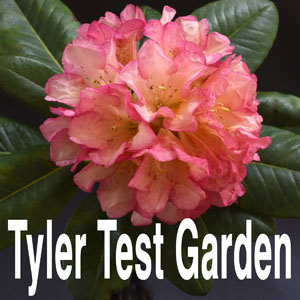
History of Rhododendron Discovery & Culture
Discovery & Cultivation of Rhododendron Species
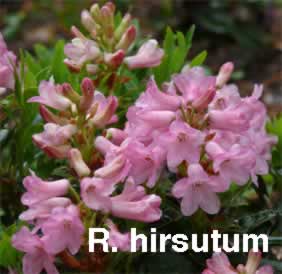 Rhododendrons are believed to have evolved from camellias, which had evolved from magnolias. The first Rhododendron to be classified and named was R. hirsutum. It was discovered by the 16th century Flemish botanist, Charles l'Ecluse, who later became called Clusius. When it was introduced to Britain in 1656 from the Swiss Alps, R. hirsutum (the Alpine Rose) was the first species of Rhododendron in cultivation. Native of the central and eastern Alps and of N.W. Yugoslavia, it was cultivated by John Tradescant 1656. Rhododendrons are believed to have evolved from camellias, which had evolved from magnolias. The first Rhododendron to be classified and named was R. hirsutum. It was discovered by the 16th century Flemish botanist, Charles l'Ecluse, who later became called Clusius. When it was introduced to Britain in 1656 from the Swiss Alps, R. hirsutum (the Alpine Rose) was the first species of Rhododendron in cultivation. Native of the central and eastern Alps and of N.W. Yugoslavia, it was cultivated by John Tradescant 1656.
When the first azaleas arrived in England is in dispute. Jane Brown, Fred Galle, Peter Cox and Ken Cox say exploration in America came in 1680 as a result of R. viscosum and R. periclymenoides seed collected in the North America by John Bannister, an English missionary, and sent to the Bishop of London, Henry Compton, in England. H. H. Davidian reports that John Bannister sent Henry Compton drawings of R. viscosum in 1691.
Davidian and David Leach state that the first actual azalea plants to be grown in England were those from seed or plants collected by John Bartram. A partnership between English Quaker Peter Collinson and botanist/farmer John Bartram of Pennsylvania led to the importation to England of the American natives, R. canescens, R. periclymenoides, and R. viscosum in 1734, and R. maximum in 1736.
As a historical reference, it should be noted that the Japanese were raising hybrids of R. indicum and R. tamurae in the 17th century. The Japanese book "A Brocade Pillow," which was published in 1692, carefully describes and classifies the color patterns of these plants that are called Satsuki Azaleas today.
It has been recorded that the first amateur collector in China was James Cunningham. He entered the service the East India Company, and in 1698 he was sent as a surgeon to Amoy, China. Later, in 1701, he set sail to Chusan (China) where he stayed for more than two years, and it was in this area where he made his collection. Cunningham sent home a large consignment of over 600 dried specimens. In 1709 he embarked to return to England and apparently died on the voyage home.
R. ferrugineum, another species from the European Alps also called the Alpine Rose, came along in 1740. The two plants called the Alpine Rose are perhaps the only rhododendrons to do well in limestone soils. Claes Alstoemer discovered R. ponticum, a native of Armenia, the country that was known to the ancients as Pontus, was found in Spain between Cadiz and Gibraltar around 1750 and it reached England in 1763. Some regions of the UK are overrun by this species.
In 1735, Karl von Linne (Latinized Linnaeus), a Swedish naturalist, proposed the currently accepted binomial system of nomenclature to replace the cumbersome descriptive method that varied from one author to another, creating much confusion. Linnaeus used the term rhododendron in 1753 for only a few species: R. ponticum of Asia Minor, R. dauricum of Siberia, R. maximum from America, R. ferrugineum and R. hirsutum of the European Alps, and the circumpolar R. lapponicum. In Linnaeus' 'Supplement', R. chrysanthum was described. He listed Azalea as a separate genus, namely A. lutea (now R. indicum), and A. viscosa (later R. nudiflora and now R. viscosum). Linnaeus first described R. canadense, the Rhodora Azalea, in 1762. It is found from Eastern Quebec to Newfoundland and Nova Scotia, and south the northern parts of Pennsylvania and New Jersey. Return to Top
The German naturalist Pallas described four rhododendron species native to eastern Europe and to Asia: R. dauricum in 1780, R. camtschaticum in 1784, R. flavum (which is now called R. luteum) in 1793, and R. chrysanthum in 1796.
Exact date of discovery for R. flammeum (also knows as R. speciosum) is not known, but plants of this species were first described by Aiton at Kew Gardens in 1789 and were probably sent there by William Bartram prior to that date.
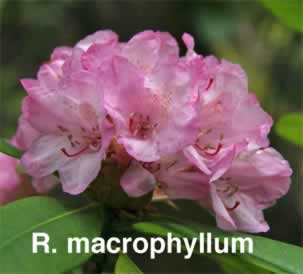 R. macrophyllum, the Pacific Rhododendron, found in the North America from Northern California to British Columbia was discovered in 1792 by Archibald Menzies Return to Top R. macrophyllum, the Pacific Rhododendron, found in the North America from Northern California to British Columbia was discovered in 1792 by Archibald Menzies Return to Top
R. carolinianum (the Carolina form of R. minus) was first collected by A. Michaux in 1792 and R. calendulaceum (the flame azalea) was first collected by A. Michaux in 1795 from the Blue Ridge Mountains of North Carolina.
By 1800 there were only twelve species known in cultivation. Gifts from the Russian collector, Count Pushkin, R. caucasicum arrived in England in 1803 and R. minus came from America in the first few years of the new century.
R. obtusum, known as a garden plant for centuries by the Japanese who called the shrub "Kirishima-tsutsuji", was mentioned in 1712 by Kaempfer, who used the Japanese name. It is a native of Japan but was introduced to England in 1844 by Robert Fortune from a Chinese garden. This 'wild' form, called R. obtusum f. japonicum by E. H. Wilson was considered by him to be the parent of all "Kurume Azaleas". This species was described as Azalea indica by Thunberg in 'Flowers of Japan' in 1784. Return to Top
| Fraser,
John (1750-1811) A Scotsman, John Fraser started
business in London as a linen-draper near the Chelsea Physick
Garden. He gave up his business to become a plant collector.
He crossed the Atlantic many times and some of our best known
shrubs were introduced by him. Among these were Magnolia fraserii,
Rhododendron catawbiense and Pieris floribunda. Return to Top |
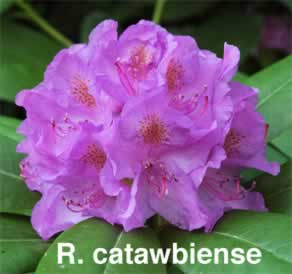 In 1809 R. catawbiense was introduced from North Carolina. It later became the principal source of hardiness in the hybrids that have graced our gardens for generations. It was collected by John Fraser and his son while collecting plants for Russian Emperor Paul. R. arborescens was first described by John Bartram in 1814. In 1809 R. catawbiense was introduced from North Carolina. It later became the principal source of hardiness in the hybrids that have graced our gardens for generations. It was collected by John Fraser and his son while collecting plants for Russian Emperor Paul. R. arborescens was first described by John Bartram in 1814.
The first of many Rhododendrons that were to come from southeastern Asia was the tree species, R. arboreum, with blood-red flowers, which was discovered by Captain Hardwicke in 1799 and arrived from India in 1811. In 1821 George Don introduced R. anthopogen and R. setosum from Asia. In 1823, R. molle, destined to become famous as one of the parents of the Mollis hybrids, was introduced from China. In 1832, R. zeylanicum (a subspecies of R. arboreum) came into England from Ceylon. From the Himalayan regions of Nepal and Sikkim, R. campanulatum was introduced in 1825 and the beautiful R. barbatum was introduced in 1849. R. scarbum was introduced by George Don in 1834 from Japan.
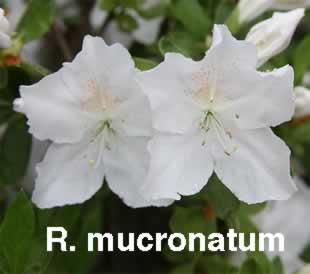 R. mucronatum (variously described as Azalea rosmarinifolia, (Johannes) Burman (1768); Azalea mucronata (Carl Ludwig) Blume (1823); Azalea indica alba, Lindley (1824); Azalea ledifolia, Hooker (1829) and other names familiar to gardeners), was mentioned by Engelbert Kaempfer in 1712 under its Japanese name "Jedogawa-tsutsuji". According to John Lindley in 1824, this species was sent to Joseph Poole from China to Brookes Nursery at Ball's Pond in 1819. Return to Top R. mucronatum (variously described as Azalea rosmarinifolia, (Johannes) Burman (1768); Azalea mucronata (Carl Ludwig) Blume (1823); Azalea indica alba, Lindley (1824); Azalea ledifolia, Hooker (1829) and other names familiar to gardeners), was mentioned by Engelbert Kaempfer in 1712 under its Japanese name "Jedogawa-tsutsuji". According to John Lindley in 1824, this species was sent to Joseph Poole from China to Brookes Nursery at Ball's Pond in 1819. Return to Top
R. japonicum (now known as a subspecies of R. degronianum) was known by other names and is often confused with the Chinese deciduous azalea species R. molle. It is native only to Japan where it is common over a great part of Hondo, the main island and elsewhere. Taken to Holland in 1830 by Philipp Franz von Siebold, it was used in hybridizing with R. molle to produce the "Mollis Azalea".
R. formosanum was introduced from India in 1832 by Wallich.
R. reticulatum, a native of much of Japan, was brought to England by Knight of Chelsea about 1832 to1833, but it may have been lost. Several later introductions were made.
In 1834, Sir William Jackson Hooker introduced R. albiflorum from the West Coast of North America. In 1835, Siebold and Zuccarini introduced R. metternichii (now knows as R. degronianum ssp. degronianum) from Japan. Return to Top
| Hooker,
Sir Joseph D.(1817-1911) A Scotsman and son of Sir William, who he succeeded as Director of Kew Gardens.
Sir Joseph Hooker returned from the Himalayas in 1850 with the
magnificent Sikkim rhododendrons. He introduced the Himalayan
birch and reported amongst other trees, the biggest of all magnolias,
Magnolia campbellii. Return to Top |
In 1849 and 1850 Sir Joseph Hooker's expedition to Sikkim in the eastern Himalayas discovered forty-five new species including the yellow-flowered R. campylocarpum and R. wightii; the red-flowered R. thomsonii; the small trees, R. falconeri, R. grande, and R. hodgsonii, with their enormous leaves; the epiphytes, R. dalhousiae and R. maddenii; the large vigorous R. griffithianum with massive white flowers; and the interesting R. triflorum, R. edgeworthii, R. fulgens, R. niveum, R. wallichii, R. lanatum, R. glaucophyllum, R. cinnabarinum, and R. lepidotum. Booth found R. hookeri and R. nuttalli in Bhutan in 1852. Planchon found R. simsii in 1854. Return to Top
| Fortune, Robert (1812-1880) Robert Fortune was born in Scotland in 1812 and in 1842 he was Deputy Superintendent of the Horticultural Society's garden at Chiswick in England. China was a country closed to all foreigners, with the exception of French Jesuit missionaries. These missionaries sent small quantities of seed back to Europe, along with reports of many wonderful plants unknown in the west. The Treaty of Nanking ended the first Opium War in 1842 and granted England the right of entry to the interior. The Horticultural Society chose Fortune to lead its first expedition even though Fortune had no experience of collecting or with the Chinese language. This 1843 expedition had limited success as the country was still in turmoil and access was still restricted to the coastal areas. Fortune not only brought back new plants but also new techniques including the art of bonsai. Fortune returned to China until 1862, and collected material from a country still in upheaval with a succession of Opium Wars. It was only later that the large collections were made by Rock, Forrest, Kingdom-Ward and Wilson. Return to Top |
In 1855 Robert
Fortune discovered R. ovatum in 1854 and R. fortunei in 1855 in Chekiang, China. It became the foundation of an important series of hybrids hardy in the United States as far north as Boston.
The next wave of exploration in 1881 was the outcome of earlier discoveries by French Catholic missionaries, Péres Armand David, Pere Jean-Marie Delavay and Paul Farges whose discovered were name R. davidii, R. delavayi, R. fargesii, and R. souliei. David also discovered R. calophytum. Delavay also discovered R. ciliicalyx, R. fictolacteum, R. lacteum, R. neriiflorum, and R. campylogynum in 1884; R. crassum and R. haematodes in 1885; R. bullatum, R. irroratum, and R. heliolepis in 1886; R. sulfureum in 1887; and R. racemosum, R. spinuliferum, R. rubiginosum and R. yunnanense in 1889; all in Yunnan, China. Farges also discovered R. adenopodum at 6,000 feet elevation in Szechuan/Hupeh, China. Rev. Souliei discovered R. chasmanthum and R. vernicosum in 1893, R. saluense in 1894, and R. wardii in 1895, in Yunnan, China. Rev. Ernest Faber discovered R. concinnum in Yunnan, China, in 1886. Many of these plants were grown from seed and introduced by Forrest.
In 1885 Baron Ungern-Sternberg discovered R. smirnowii and R. ungernii in the Caucasus Mountains. Return to Top
| Wilson, Ernest Henry (1876-1930) Wilson was born in Chipping Campden, England in 1876, 33 years after Robert Fortunes first Chinese expedition. In 1897 he obtained a position at Kew. In 1898 the Managing Director of the famous Victorian Veitch Nurseries asked the Director at Kew to recommend a young man to travel to China to find a source of The Handkerchief Tree--Davidia involucrata. Wilson was recommended. The first trip lasted for three years. Wilson found not only the Davidia in the mountains of Northwestern China but 400 additional new plants. Subsequently he found many new rhododendrons, roses, primula and Meconopsis. Such was Wilson's reputation that in 1906 his ties with Veitch were severed and he was recruited by the Arnold Arboretum in Boston, Massachusetts. The Director of the Arboretum at that time, Professor Charles Sprague Sargent, used Wilson's talents all over the world in search of new species for the Arboretum--Japan, Korea, Australia, New Zealand, India, Africa and, of course, China. Wilson was estimated to have introduced 2000 new species in a four month period and much of the original material collected by Wilson can be seen at the Arnold Arboretum. Return to Top |
The discoveries by the French missionaries
led to a systematic search stated in 1899 and followed up in 1903-4
by Dr.
Ernest Wilson for plants in China. Wilson found R. discolor, R. praevernum and R. ponticum in 1900; R. micranthum and R. sutchuenense in 1901; and R. ambiguum, R. intricatum, R. longesquamatum, R. obiculare, R. oreodoxa, R. tricanthum, R. wasonii, and R. davidsonianum in 1904 in Szechuan, China. Wilson introduced R. insigne R. williamsianum in 1908 and R. moupinense in 1909.
Wilson's work lead to a flood of expeditions by plant explorers to Asia. In 1904 George Forrest and Reginald Farrer explored Yunnan, China. Forrest discovered R. haemaleum and R. strigillosum in 1904; R. forrestii in 1905; R. oreotrephes in 1906; R. fulvum and R. sinogrande in 1912; R. puralbum, R. scintillans, and R. russatum in 1913; R. griersonianum and R. meddianum in 1917; R. keleticum and R. scyphocalyx in 1919; and R. taggianum in 1925. Forrest's and Farrer's work was carried on by Captain F. Kingdon-Ward in 1911, and Dr. Joseph F. Rock in 1920, the partners Ludlow and Sheriff and others. Kingdon-Ward discovered R. chryseum at 13,000 feet in Yunnan, China, in 1912; R. hippophaeoides at 12,000 feet in Yunnan, China, in 1913; R. megacalyx at 8,000 feet and R. calostrotum at 11,000 feet in Burma in 1914; R. leucaspis and R. valentinianum at 11,000 in Yunnan, China; R. pemakoense in Tibet in 1924 and R. recurvoides in July 1926 in the valley of the Di Chu in Upper Burma. Farrer and Kingdon-Ward discovered R. aperantum, which was introduced by Forrest. Farrer discovered R. sperabile in Tibet in 1919. Forrest found and introduced R. stewartianum in Yunnan, China, in 1904; R. impeditum in Yunnan, China, in 1911; R. diaprepes in Yunnan, China, in 1913; R. eriogynum in Yunnan, China, in 1914; and R. didymum, R. eclecteum and R. eudoxum in Tibet in 1917. Farrer discovered R. caloxanthum in the Tibet/Yunnan region in 1919 and R. tephropeplum in Burma in 1920. Two new species, R. concatenans and R. xanthocodon were identified from seed collected by Kingdon-Ward. Return to Top
| Forrest,
George (1873-1932) Scotsman George Forrest was the greatest of all collectors of rhododendrons, introducing hundreds of species from China and Tibet to Edinburgh Botanic Garden, including R. giganteum and R. sinogrande. Sponsored by the seedsman, A.K.Bulley of Ness, he went to China in 1904. He also specialized in primulas. The list of material collected by Forrest is impressive and includes Abies georgei, Abies forrestii (a beautiful silver fir), Acer forrestii (snakebark maple), Adenophera, Aster, Dacocephalum, Hemerocallis, Iris, Primula and Rhododendron forrestii. Return to Top |
Meanwhile Dr. Augustine Henry, a medical officer, discovered R. augustinii in Szechuan, China, and R. racemosum was discovered by Delavay in Yunnan, China, in 1889. R. griersonianum and R. arizelum were discovered by George Forest in 1917 at about 10,000 feet elevation in Yunnan, China. Return to Top
| Aberconway, Henry Duncan, 2nd Baron (1879-1953)
Encouraged by his mother, Laura, the first Lady Aberconway, the
Second Baron Aberconway developed the magnificent gardens of
Bodnant [http://www.sisley.co.uk/bodnant.htm] in North Wales
over 50 years from 1901. Assisted over most of this time, as
head gardeners, by three successive generations of the Puddle
family. Lord Aberconway subscribed to many plant hunting expeditions
and hybridized rhododendrons and other plants, many of which
have gained worldwide fame. Return to Top |
In 1937, R. aberconwayi was grown from seed from eastern Yunnan sent by Chinese assistants of George Forest to Lord Aberconway after Forest's death in 1932. Return to Top
| Ward,
Frank Kingdon (1885-1958) Frank
Kingdon Ward
began his many plant hunting expeditions in 1911. He traveled widely in the Himalayas and published several readable
accounts of his experiences in the 1920s including The Riddle
of the Tsangpo Gorges and The Romance of Plant Hunting. He collected
unusual primulas, lilies, rhododendrons and gentians. He studied
the distribution of the Meconopsis in Tibet. He is perhaps the greatest and most dedicated of all plant hunters. By his last expedition in 1956-7 to Ceylon, he had documented and collected 23,068 specimens. Return to Top |
Most rhododendron species, over 900, are found in Southeast
Asia, ranging from the Himalayas through Tibet, Burma, China,
Thailand, Viet Nam, to Malaysia, Indonesia, Philippines and New
Guinea. The distribution of native species extends down to northern
Australia, up to Siberia, and around the world. Europe has 4 species,
and in North America about 28 species are found. Return to Top
| Ludlow, Frank (1895-1972) With George Sherriff,
Frank Ludlow is well known for his discovery of rhododendrons
and primulas on expeditions to Tibet. They found better forms of many previously discovered rhododendrons. They are called the "L & S form." Return to Top |
A recent major discovery of a rhododendron is that of R. degronianum ssp. yakushimanum (aka. yakusimanum) first described by Japanese botanist T. Naki in 1920. Fortunately a Japanese botanist and nurseryman Dr. Wada sent two plants to Lionel de Rothschild's garden at Exbury in the south of England in 1932. Many forms of R. yakushimanum have been identified and most are considered to be subspecies of R. degronianum. Some are identified as subspecies of R. makinoi and R. keskei.
Other recent discoveries of new species include the giant yellow flowered R. sinofalconeri, the red species from the Yunnan/Sichuan border R. ochraceum, and the pink dwarf species R. dendrocharis. And more recently Kenneth Cox led an expedition to Tibet that discovered R. bulu and R. dignabile.
Two deciduous azalea species were recently discovered in Alabama (USA). R. eastmanii was discovered by Charles Eastman in 1980s and named in 1999. R. colemanii was discovered S. D. Coleman, Sr., in 1990s and named in 2008.
From 2010 to 2020, 60 new species were reported. That is 6 per year on average. In 2019 and 2020 the following were reported:
- R. pudingense by X.Y.Dai, C.H.Yang & Y.P.Ma, in PhytoKeys 146: 54 (2020) in Guizhou, China
- R. rimicola by X.L.Tian, Y.P.Ma & J.Nielsen, in Phytotaxa 395(2): 66 (2019) in Yunnan, China
- R. sohayakiense by Y.Watan. & T.Yukawa, in PhytoKeys 134: 105 (2019) in Shikoku & Honshu, Japan
- R. widjajae by Argent & Mambrasar, in Reinwardtia 18(1): 27 (2019) in Sulawesi, Malesia
- R. suoilenhense by D.F.Chamb., N.T.T.Huong & Rushforth, in Bot. Mag. 36(4): 423 (2020) in northern Vietnam
- R. xishuiense by C.H.Yang & C.D.Yang, in Phytotaxa 429(3): 248 (2020) in Guizhou, China
Return to Top
Also see the History of the Genus Rhododendron and
History of the First 50 Years of Rhododendron Hybrids and Hybridizers
Directory of Contents for Henning's Rhododendron & Azalea Pages
•• Providing Information about the Genus Rhododendron since 1996
••
Articles Published by the American Rhododendron Society
Return to Top

Last Updated:
July 6, 2020
|